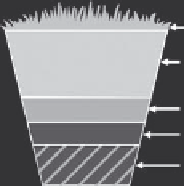Environmental Engineering Reference
In-Depth Information
Contaminants are
destroyed through
photolysis
Ground surface
FIGURE 11.4
Example of natural attenuation. (From United States
Environmental Protection Agency (USEPA),
A Citizen's
Guide to Monitored Natural Attenuation
, EPA 542-F-01-
004, Office of Solid Waste and Emergency Response,
Washington, DC, 2001b.)
Gases rise
through soil
Chemical
evaporates
landfarming techniques associated with passive bioremediation and it involves mechani-
cal turning or tilling of the impacted soil so it can more readily evaporate, or induce more
efficient photolysis through direct exposure to sunlight (USEPA 2007).
11.3.5 Capping
Capping is routinely used at sites where the highest concentrations of contamination have
been removed or remediated, but an additional level of protection is still required. Sites
eligible for capping include those contaminated beyond the level adequately addressed
by monitored natural attenuation, or where natural attenuation is not expected to occur,
as with many heavy metals. Capping can take several different forms including asphalt,
concrete, geosynthetic liner, and many others, but must be maintained regardless of the
material selected. Some caps are constructed using many different layers, which is typical
for many closed landfills (USEPA 2002, 2003). An example of an engineered multilayer bar-
rier cap is shown in Figure 11.5.
11.3.6 Land Use Restrictions
Land use restrictions are common at many remediated sites of environmental con-
tamination. They are employed to minimize the potential for exposure to low-levels of
Vegetation
Fine-grained layer
Coarse-grained layer
Interim cover
Waste
FIGURE 11.5
Example multilayered cap. (From United States Environmental Protection Agency (USEPA),
Evapotranspiration
Landfill Cover Systems Fact Sheet
, EPA 542-F-03-015, Office of Solid Waste and Emergency Response, Washington,
DC, 2003.)



Search WWH ::

Custom Search